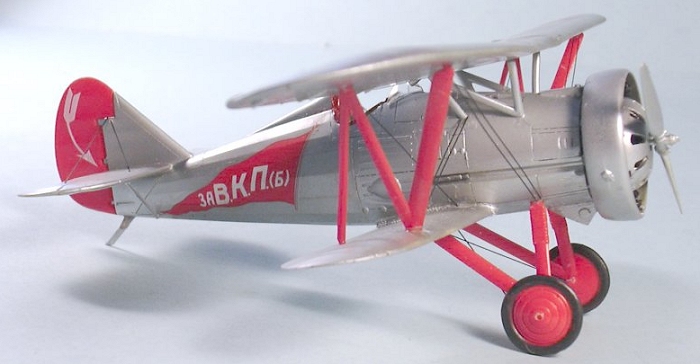
Rest Models 1/48 Polikarpov I-5
| KIT #: | RM 4805 |
| PRICE: | $58.00 from DMC Models |
| DECALS: | Three options |
| REVIEWER: | Tom Cleaver |
| NOTES: | Resin kit with photo etch and cast metal parts |

| HISTORY |
Following the success of the Bolshevik Revolution of 1917, and the consolidation of power in the Soviet Union in the early 1920s, the Russian aviation industry began to take more direction. At the outset, the Red Air Force was using western designs that had been license-built in under the Czarist regime during the First World War. These aircraft were clearly now obsolete. Without a continuing cadre of experienced designers, the industry produced more license-built foreign designs, while experiments continued with local design and innovation.
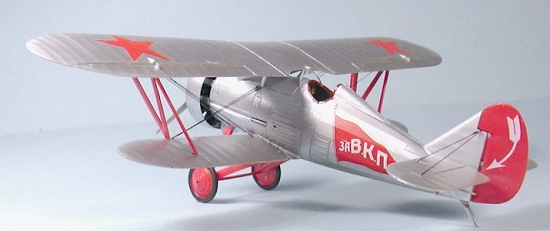 During the revolution, the de Havilland DH-4 was put into production as the
R-1, with 63 produced at the GAZ-1 factory. This event was of more than
passing interest, since it marked the first major involvement of Nikolai
Polikarpov in aircraft design and manufacture. Polikarpov was responsible
for adapting the design for local production with extensive substitution of
more modern materials, and he essentially recalculated the entire design to
accomplish this successfully. Following the end of the Civil War, 2,700
R-1s were built, becoming the first mass-produced airplane of the Soviet
aircraft industry.
During the revolution, the de Havilland DH-4 was put into production as the
R-1, with 63 produced at the GAZ-1 factory. This event was of more than
passing interest, since it marked the first major involvement of Nikolai
Polikarpov in aircraft design and manufacture. Polikarpov was responsible
for adapting the design for local production with extensive substitution of
more modern materials, and he essentially recalculated the entire design to
accomplish this successfully. Following the end of the Civil War, 2,700
R-1s were built, becoming the first mass-produced airplane of the Soviet
aircraft industry.
During the early 1920s, Polikarpov continued designing and constructing experimental aircraft, including the two-seat DI-1. His first successful design was the I-3, which became the standard Soviet Air Force fighter aircraft with nearly 400 produced from its introduction in 1927 until it was replaced by Polikarpov’s next design, the I-5, in the early 1930s. The I-3 used a BMW liquid cooled engine, which the Soviets built under license as the M-17, and was armed with two 7.62mm machine guns. Pilots reported the I-3 had fair maneuverability, though it required a long takeoff roll.
Following the success of the I-3, Polikarpov was assigned to develop the
I-4 fighter for delivery in August 1930 under the provisions of the 1928
Five Year Plane for experimental aircraft design. Due to unforseen problems
with the design, construction fell behind schedule. The entire 1928 plan
was unrealistic in its expectations, and in April 1938 Polikarpov was among
450 aircraft designers and engineers who were arrested by the State
Security Agency, the OGPU, and charged with being “saboteurs and enemy
infiltrators” for failing to meet the plan. The OGPU wanted to show Stalin
that fear and 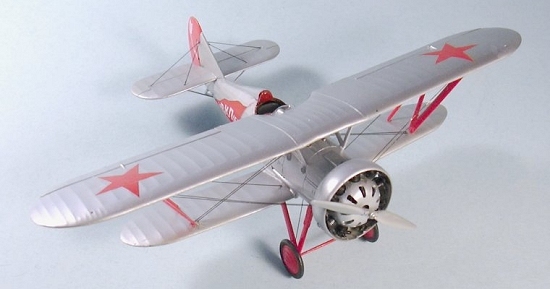 repression would be the best motivators to improve Soviet
industry. Polikarpov was sentenced to death, which was later commuted to
life imprisonment in a prison design bureau. He was among 300 who survived
the purge.
repression would be the best motivators to improve Soviet
industry. Polikarpov was sentenced to death, which was later commuted to
life imprisonment in a prison design bureau. He was among 300 who survived
the purge.
Daniel Grigorivich was among the designers arrested and sent to prison design bureaus, for having failed with his I-6 design. Polikarpov was assigned to work with Grigorivich, and the two were ordered to design a fighter that would meet the specifications. The result was the VT-11, a single-seater whose fuselage was constructed with a metal frame, using wooden wings. The prototype was flown in April 1930 by Ivan U. Pavlov. The VT-11 was found to be underpowered with the M-15 radial and it was determined that the M-22 - a license-built Bristol Jupiter - would be used in the production airplane, which was assigned the type designation I-5.
Stalin reportedly saw one of the prototype I-5s perform an aerobatics routine during the summer of 1930, and as a result he released Polikarpov to reassume his duties. Production of the new type faced serious complications because it had been assigned to the unfinished Factory Number 21. As a result, it took until 1932 for the I-5 to enter mass production. In a time when western designers considered an order for 50 airplanes a major success, no fewer than 830 I-5s would be produced by 1936.
Standard armament was two PV-1 7.62mm ShKAS machine guns. Ten I-5s were equipped with four PV-1s but this armament would not see operational use until the introduction of the successor to the I-5, the superb I-15 - the first Soviet aircraft to outperform its western contemporaries. The I-5 itself had outstanding maneuverability, and was considered similar in performance to the RAF Bristol Bulldog, which was its nearest contemporary in service.
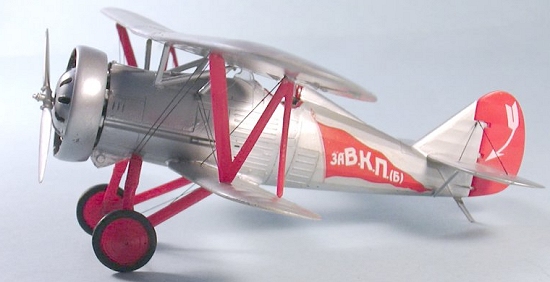 The I-5 was used by the first Red Air Force flight demonstration team,
known as the Red Banner Demonstration Team, a six-plane formation formed in
1933 and led by Vitaly A. Stepanchenok.
The I-5 was used by the first Red Air Force flight demonstration team,
known as the Red Banner Demonstration Team, a six-plane formation formed in
1933 and led by Vitaly A. Stepanchenok.
The I-5 was also successfully used in the amazing “Zveno” program, in which Tupolev TB-1 and TB-3 four-engine bombers were to carry several single-seat aircraft which could be released to either defend the bomber against defending fighters, or be used for strike missions at distances beyond the standard range of the fighters. In September 1933, a TB-1 carried two I-5s mounted above the bomber’s wings. A year later in August 1934, a TB-3 carried three I-5s mounted above the wings and fuselage. In both experiments the I-5s were successfully flown from their mother ship. The I-5 was also used for the development of the RS-82 air-to-air and air-to-ground rockets that would be used in large numbers during the coming war.
The I-5 was replaced in frontline service by 1937 with the I-15 and I-16. The surviving I-5s were used as advanced trainers until the German invasion in 1941. Heavy aircraft losses at the start of the German invasion forced the Red Air Force to use refurbished I-5’s for ground attack missions on the Crimean peninsula and as night bombers during the Battle of Moscow.
| THE KIT |
For a look at what’s in the box, please visit the preview.
| CONSTRUCTION |
This is the best-designed resin kit I have ever built. A modeler should use gloves to protect his hands when handling the wings and horizontal stabilizers, since the trailing edges are that sharp!
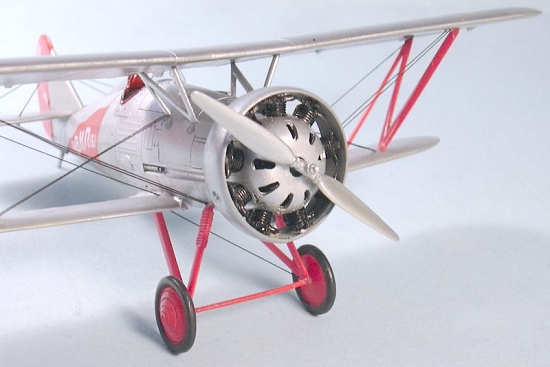 There was only a very little bit of flash to clean off the parts, all of
which fit together as well as anything from Tamiya and presented no
difficulties whatsoever. Parts design is so good that even the simple
exploded-figure instruction sheet was more than sufficient to guide
assembly
There was only a very little bit of flash to clean off the parts, all of
which fit together as well as anything from Tamiya and presented no
difficulties whatsoever. Parts design is so good that even the simple
exploded-figure instruction sheet was more than sufficient to guide
assembly
I had decided to build the boxart airplane, which is one of the six that served in the Red Banner Flight Demonstration Team. I believe this airplane was one of the ten built with a four-gun armament, since the kit comes that way, and this version has a different interplane N-strut and a beefier landing gear than is used for the other two possibilities, which are straight service types. These parts are resin, while the lighter parts for the other versions are done in white metal. I expected some problems with the struts but had none. The only change I made was to use a smaller seat from the parts box, since it fit easier. I particularly liked the way the fuselage was molded in one hollow piece, into which I placed the assembled cockpit and then attached the forward fuselage to this subassembly.
Assembly of the kit was accomplished over a weekend, and the model was ready for the paint shop.
| COLORS & MARKINGS |
Painting:
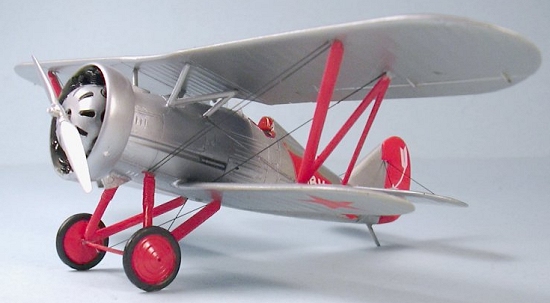 I painted the interplane N-struts, landing gear and separate rudder with
Xtracrylix RLM23 Red, which was the same shade as the decals.
I painted the interplane N-struts, landing gear and separate rudder with
Xtracrylix RLM23 Red, which was the same shade as the decals.
The model was painted overall with SNJ Aluminum, which was then masked over the fabric areas, and the metal areas of the forward fuselage and the cowling were painted with Alclad II “Duraluminum.”
Decals:
When everything was dry, I applied the kit decals directly over the metalizer paint with no problem. The decals went down smoothly under a light coat of Micro-Sol. The model was done in the markings of the Red Banner Flight Demonstration Team. O applied a light coat of ModelMaster metalizer sealer over the fabric area to protect the decals, which also gave the SNJ paint the texture of aluminum dope.
| FINAL CONSTRUCTION |
I glued the cabane struts in position and then attached the upper wing with no problem. I did have to test-fit and trim the interplane N-struts, but this was not difficult. I then attached the landing gear. The model was rigged with .008 brass wire painted black.
| CONCLUSIONS |
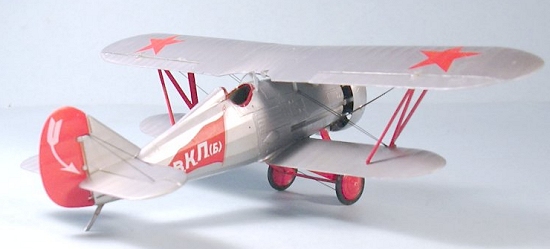 This is one of the easiest biplane models I have ever done and it is far
and away the very best resin kit I have ever built, since it presented none
of the usual fit problems associated with resin kits. I am looking forward
to doing other kits from this manufacturer. Other manufacturers doing
resin kits could do far worse than look at these kits as representative of
what a resin kit should be.
This is one of the easiest biplane models I have ever done and it is far
and away the very best resin kit I have ever built, since it presented none
of the usual fit problems associated with resin kits. I am looking forward
to doing other kits from this manufacturer. Other manufacturers doing
resin kits could do far worse than look at these kits as representative of
what a resin kit should be.
The I-5 may be little-known in the West, but it was an historically-significant airplane in the development of the Soviet aviation industry. Modelers who like airplanes from the Between-Wars period can buy this in confidence of having an enjoyable project and a good-looking model as a result. This looks great sitting next to my other Polikarpov I-15s, I-152 and I-153s.
March 2005
Copyright ModelingMadness.com. All rights reserved. No reproduction in part or in whole without express permission.
If you would like your product reviewed fairly and fairly quickly, please contact the editor or see other details in the Note to Contributors.